Have you taken on a new role as a manager and need to deliver performance and success? Or are there significant changes in your team? Or in your strategy, organization or processes? Are you observing disruptions or blockages? Or do you simply want to activate and focus your team even better?
What are good, strong, resilient and high-performing teams?
Patrick Lencioni and other researchers like to call good, strong, resilient, high-performing teams “high-performance” teams. Science has empirically derived the following success factors that are strongly pronounced in high-performance teams(described in more detail here):
- Trust within the team and between team and manager
- Passionate, open approach to conflicts
- Individual commitment from managers and team members
- Good teamwork, intensive exchange and mutual supervision and mentoring
- Identification of manager and team members with a clear, common goal
If these success factors are pronounced in your team, this leads to higher performance and quality, better decision-making, increased satisfaction, greater goal achievement and higher employee loyalty.
Managers often find it difficult to strengthen these success factors in their teams. Why?
- New managers and new teams are being formed at the content level, changing or developing the organization and processes. At the same time, day-to-day business has to be managed. Attention is then usually not focused on the success factors mentioned.
- If you want to consciously work on the success factors mentioned, it takes time for managers and the team. Time that is taken away from core tasks and that people often believe they do not have.
- The success factors describe the group dynamics in the team. It is about energy, individual wishes and imprints, behavioral patterns in the team, established team culture, etc. These are highly complex aspects. These are highly complex aspects.
- Changes often require an understanding of group dynamics and psychology and in many cases can only be effectively triggered by interventions “from outside” .
How do team coaches help to build high-performance teams?
Systematic team development around the success factors mentioned above is the core of our work as team coaches. Based on our experience, we have developed this curriculum with tried-and-tested interventions and a sequence that builds on each other.
Essentially, we help teams to clearly answer the following three questions:
| We? | Is there a real “we” feeling? Is there trust and a community? Motivation and energy in a common direction? |
| Where to? | Is there a clear “where to”? Not only on a factual level (e.g. as a PowerPoint), but also as a feeling? As a meaning? Is the team really convinced of the “Where to?” and does it represent it internally and externally? |
| Why? | What really drives the team? What are resources? Sources of energy? Or what is blocking or slowing down the team? Are there hidden or open vested interests? |
What is our role here? We see ourselves as a catalyst, as a mirror and want to strengthen the inherent strengths of the team and the managers. We do not teach, we do not advise from above. Instead, our work is in partnership with managers and teams and always follows the “mantra” – strengthen leadership, don’t replace leadership!
Having us accompany your teams as team coaches has the following advantages:
- You use extensive experience in developing your teams along the success factors.
- You will be supported by experts with the necessary psychological training who know which interventions bring about real change for which team.
- You reduce the time spent on your managers and teams.
- Your managers can incorporate elements of the curriculum directly into their respective teams. This allows you to scale team development within the company.
- You use tried-and-tested diagnostic tools and save time in the preparation of team events.
- Your managers can concentrate on their leadership role as part of the team and are supported ‘from the outside’, impartially and independently.
We are happy to support you in the initial diagnosis of your team’s situation, in adapting the curriculum to your needs and, of course, in the preparation, implementation and follow-up of the joint events. Get in touch for an exchange of ideas!
The individual components of our curriculum are described below.
- What are good, strong, resilient and high-performing teams?
- How do team coaches help to build high-performance teams?
- Building block 1: Create a safe space
- Module 2: Learn to argue more passionately
- Building block 3: Sharpens the common goal, develops a common self-image
- Building block 4: Strengthen the individual commitment of your team members
- Module 5: Activates collaboration, leverages synergies and uses supervision and mentoring
The 5 building blocks of our curriculum
Building block 1: Create a safe space
In the first module, you will develop the success factor “trust”. This is about trust at the relationship level, which means that team members know that their individual actions and statements will not be used against them by other team members or managers.
You see your team as a group of people with mutual expectations and feelings. You recognize destructive tendencies for games and intrigues and seek openness and honesty instead. You look at disappointments and injuries and can then look forward together again. Closeness and a safe space are created in your team – Simon Sinek calls thisthe “Circle of Safety“.
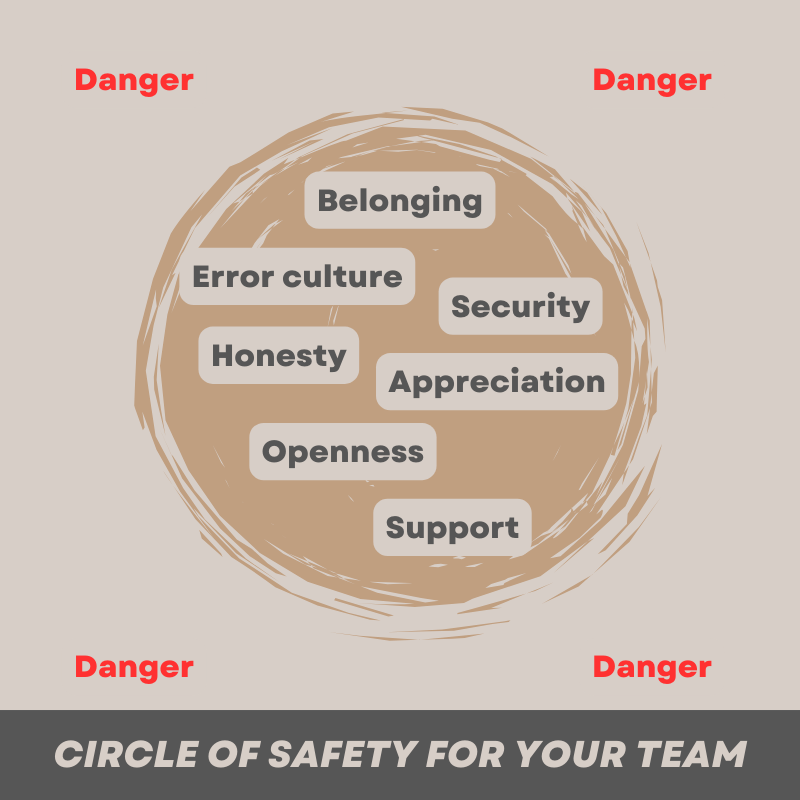
This safe space is the basis for your open and constructive collaboration, for good communication, for new ideas to be introduced, for innovation to emerge and for your team members to find their optimal role in the team.
This first building block is not about team building, not about “feeling good”, not about memories and cool events, but about deep understanding, clarity, honesty, fairness and trust. Trust is the basis for all other building blocks – we start (almost) every team development with this building block.
Module 2: Learn to argue more passionately
“Why argue? Isn’t arguing destructive, brings negative emotions to the surface and stops us from working? And now we’re supposed to learn to argue passionately?”
If you think managers know best, they are responsible for the detailed definition of team goals, processes and organization. They know all procedures, processes and problems in detail and even see new problems immediately, are supposed to resolve conflicts and are the immediate escalation authority and sole source of ideas for innovation – if we believe all this, then you don’t need a culture of conflict.
You need a passionate culture of debate in order to:
- Identifying new problems in established processes at an early stage and discussing them in the team and with the manager
- Utilize different perspectives and experiences of team members to find optimal approaches to problems
- Generating innovative ideas from within the team and ‘disputing’ them constructively and passionately without regard to hierarchy and established patterns
- To advance the team by thinking outside the box
- To enable a high level of emotional identification of the team with new solutions and acceptance of jointly made decisions
- Resolvingunspoken frustrations that are ‘sand in the gears’ through the team itself
- To strengthen the ‘safe space’ through the experience of each individual that they can contribute, that they are valued, that their ideas are accepted and not devalued
Your team learns to argue passionately, regardless of ‘it’s always been this way’, hierarchy or power – but within the ‘safe space’ of mutual trust and appreciation.
You are not working on “theoretical issues”, but on your specific topics and taboos. Your team and managers learn to walk the fine line between leaving room for discussion and making quick decisions.
The basis of your work on “learning to argue” is the work of Klaus Eidenschink (“The Art of Conflict”), who will help your managers and teams to understand the “anatomy of conflict” and to deal with it more confidently:
- How do the disputants deal with the conflict on a factual level ? What is the focus? How is the matter described? And how is it evaluated?
- How does the conflict manifest itself on a social level? Is contact sought in a ‘hostile’ or dialogical manner? Are positions determined or are views explored? How do the disputants react?
- Finally, how does the argument itself proceed? Is the argument logical (A, B, C), stringent, simple, linear, so to speak, or are complex relationships and ambivalences ‘allowed’? Are threats made with power or is there negotiation? Do the disputants have clear positions or are they uncertain? Eidenschink calls this the temporal dimension.
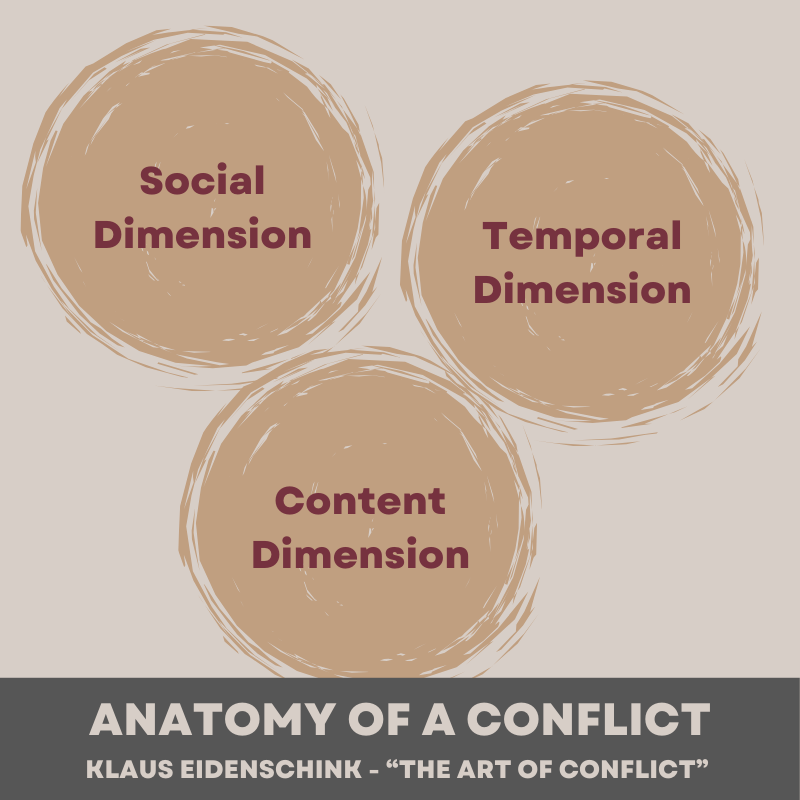
Your team will learn to understand what blocks passionate arguing. Is it your history? Your corporate or team culture? Lack of conviction and motivation? Suboptimal decision-making and escalation processes? Unaccepted top-level decisions?
This step builds on the ‘trust’ building block. Without trust, there can be no good culture of debate. No good decisions without a good culture of debate.
Building block 3: Sharpens the common goal, develops a common self-image
“We already have a strategy. It’s absolutely clear where we want to go and the team knows the PowerPoint too.” – We often hear thoughts like this.
However, your focus in this module of the curriculum is not on these classic aspects of strategy development. Instead, you will look at the following specific questions:
- Is your goal complete, operationalizable and meaningful? Here we use the concept of the three overlapping thematic areas of the strategy (see illustration):
- The “Content” topic area describes the “What?” – i.e. the hard aspects (e.g. product, customer, market and competitors).
- The subject area “Organization/Processes” describes the “How?” (organization, processes, etc.).
- The ‘meaning’ theme describes the‘why‘ (meaning, self-image, feelings, team culture). Only the third theme enables the team to identify with the goal.
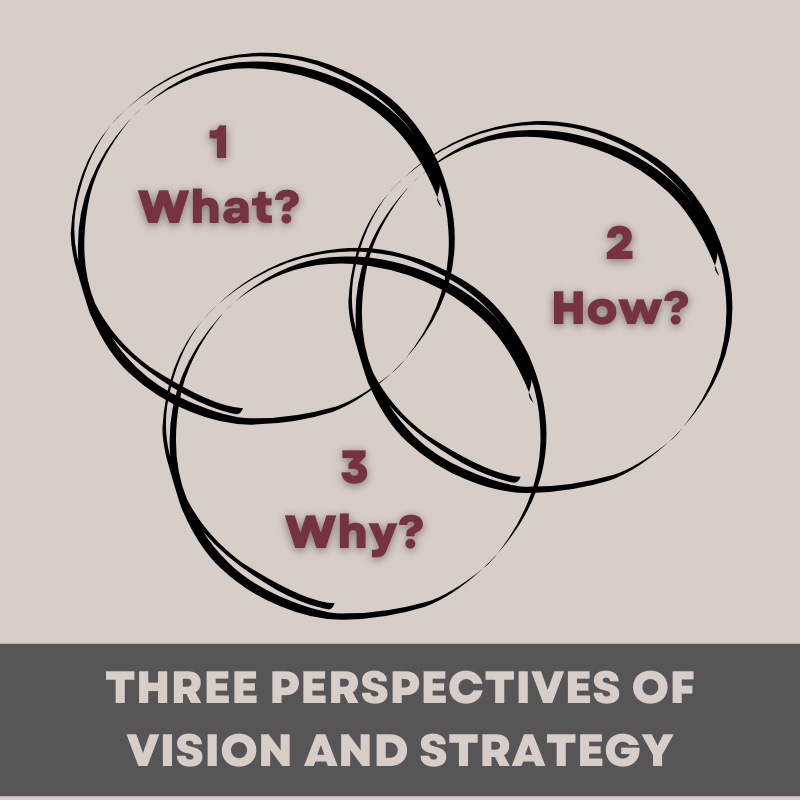
- How consistent are goals along these three themes? Or are there contradictions? For example, does your team see itself as a “premium team”, but the strategy envisages efficient, low-cost services? Do your organization and processes fit both the “Why?” and the “What?”?
- How well do your managers and teams manage to translate this goal into internal and external messages, thereby conveying authenticity and energy?
- How strong Do your team and your managers identify with this goal? How much strong and clear self-image is created?
- How can you ensure more identification with the goal and therefore more energy?
Finally, the scientific studies cited above describe the factor for high-performance teams not as “there is a PowerPoint on the vision” but as “the team consistently pursues a common goal”.
After the first two building blocks of the curriculum, experience has shown that the desire within the team to sharpen the common goal is quite pronounced – and should therefore almost necessarily be tackled as the next step.
Building block 4: Strengthen the individual commitment of your team members
What do you actually understand by the individual commitment of your team members? What does this have to do with the team goal? How is the team goal created in the first place? And how can you use clarifications around the team goal to strengthen commitment?
Concepts of group dynamics help you to understand how your team’s goal pool is initially formed from the goals of the individual team members. This pool of goals can contain conscious and unconscious, explicit and hidden goals. And the goals in the target pool are very likely to be contradictory across all team members.
Your team then negotiates one or more team goals from this pool of goals more or less openly, more or less controlled from above, more or less fairly. Here too, contradictions between individual goals, negotiated team goals and corporate vision and strategy are to be expected.
In our curriculum, you first make your team aware of this target pool and the negotiation process. This shows your team which conflicts of objectives (conscious & unconscious; expressed & unspoken) are present, have not really been resolved and may be sabotaging the identification of team members with the team objective. If necessary, we accompany the processing of these conflicts.
You then take a look at individual motivation and the energy in the team as a whole. You look at individual needs (such as closeness/distance, freedom/safety or specialness/belonging) – knowing that better fulfillment of needs leads to more satisfaction, balance and energy. You look at other sources of energy at an individual and team level (safe space, development potential, personal connection, meaning, appreciation …) as well as potential energy guzzlers. Transparency about energy sources (often also called “resources”) helps your managers and teams to consciously strengthen them.
Finally, you identify ways in which your team can rally more clearly and strongly behind the team goal over time. This helps your team members to contribute more optimally – more optimally both in terms of their individual needs and goals and in terms of the team goal.
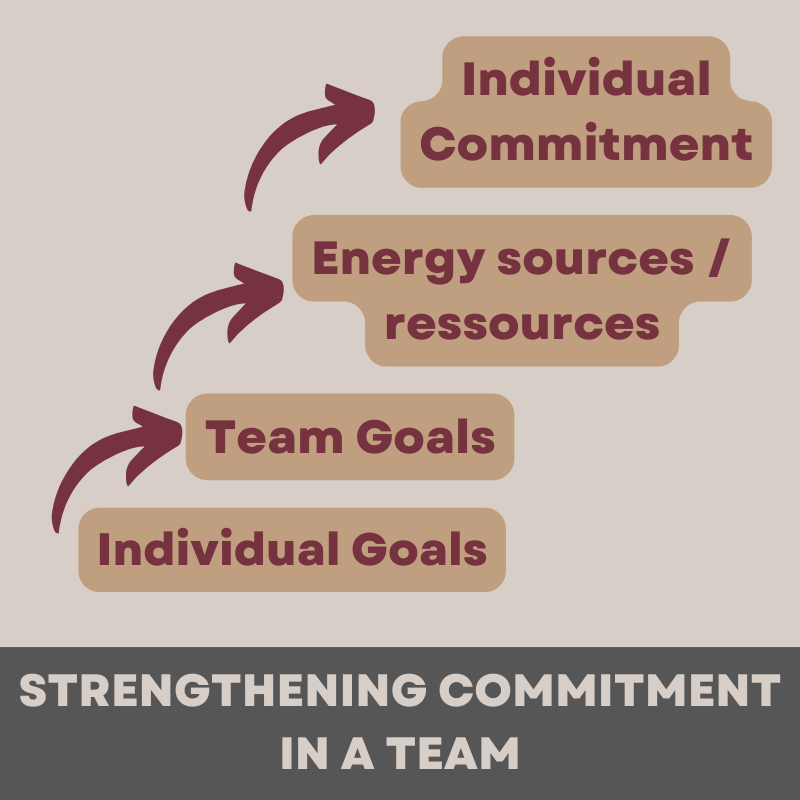
This step sounds simple – but it is not, as it first requires your team members to take a close look at themselves. This will almost certainly bring unconscious, individual issues to the surface, which need to be given space.
Module 5: Activates collaboration, leverages synergies and uses supervision and mentoring
Clear roles and tasks in your team help in day-to-day business and are absolutely essential. Too much ‘clarity’, however, leads to silos, with the following consequences:
- Concrete cooperation (interfaces, communication, etc.) not optimal
- Too little exchange of ideas, experiences, procedures
- Too little mutual support (mutual supervision / mentoring)
- Too little continuous learning, too little ongoing optimization of roles, tasks and collaboration
You will start this module with a joint, structured analysis:
- How clearly are the roles and tasks of the team members derived from the common goal (Building Block 4)? Is there a need for sharpening/clarification? Is the management and incentive system consistent?
- What are the needs of individual team members, managers or the team as a whole in terms of collaboration, exchange, supervision/mentoring on the one hand and conflict resolution on the other?
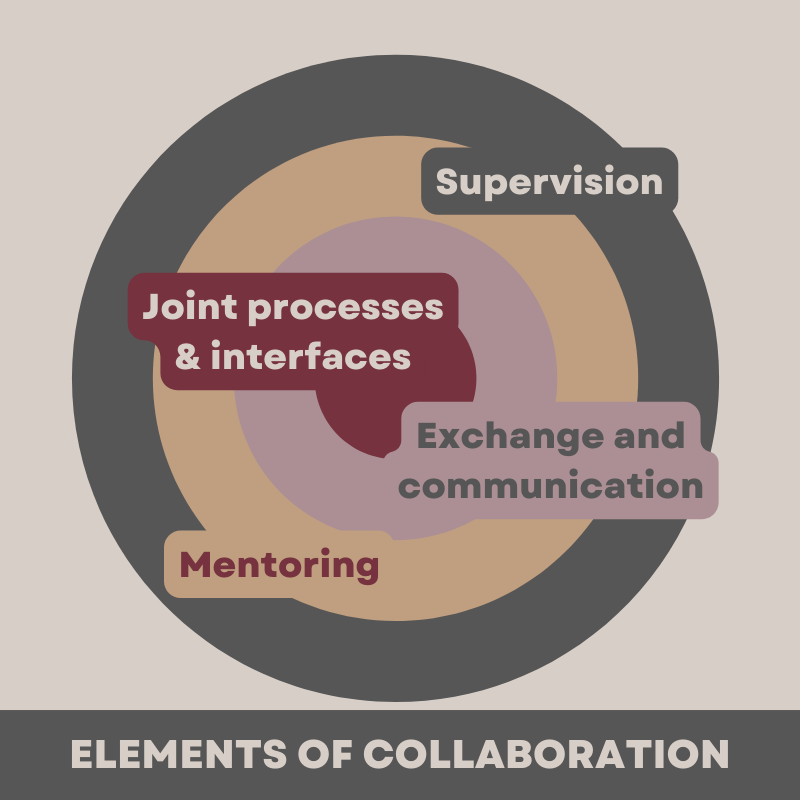
You identify sources of conflict and try to discuss taboos. These can result from personal sensitivities as well as from group dynamics (sub-groups, rope teams) or from the history of your team (e.g. mergers, departure of key people, etc.).
On this basis, you identifythe need for action, open issues and tasks to be pursued and prioritize them. In doing so, you consider content, organization/processes as well as the relationship level.
The procedure
Our team support is always individually tailored to your situation. We talk to you to understand your initial situation. We set priorities together, change the order of the topics if necessary and combine the ‘softer’ topics (e.g. self-image and culture) with your individual tasks (e.g. the development of your strategy or improvement of organization or processes).
Our program can be carried out over a period of 6 months (“fast-track”) with monthly appointments or with a longer time horizon, with appointments every 3 to 6 months. The development of the team is regularly reviewed by means of anonymized quantitative and qualitative surveys. The next module is adapted on this basis as required.
Alternatively, if there is an urgent need for one of the success factors, you can of course also separate out individual modules of the program and hold them as individual events.
Decided measures are followed up in regular, short catch-ups in the team, which are accompanied by us. The team and we also use these catch-ups to discuss the topics from the last meeting, to consolidate the learning content and to share experiences.
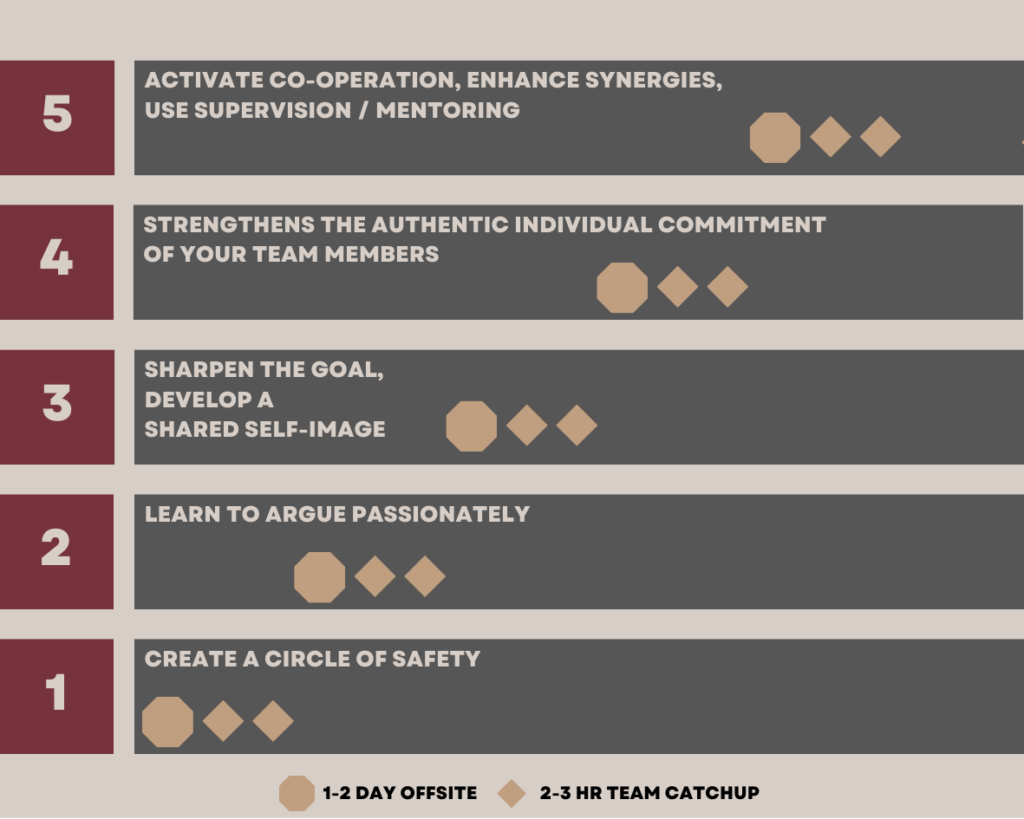
In all five modules of our curriculum, additional, individual coaching for your managers can be helpful, for example on issues relating to building a “safe space”, communication and conflict management, group dynamic challenges or supervision, mentoring and leadership.
